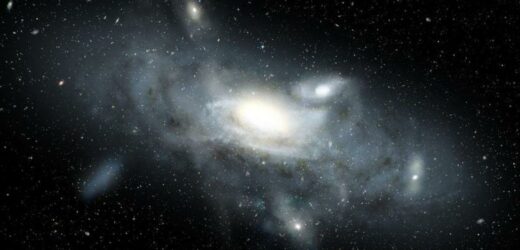A galaxy located a whopping 9 billion light years away across the cosmos is a youthful mirror for our Milky Way, a study has found. Dubbed the “Sparkler”, the galactic doppelganger is surrounded by a system of star clusters and satellite galaxies — which it is absorbing as it grows. Studying the Sparkler and its clusters, the astronomers said, provides a unique insight into the infancy of galaxies like the Milky Way.
The Sparkler was discovered using some of the first data collected by NASA’s new James Webb Space Telescope, which came online last year.
The galaxy was named in reference to how it is surrounded by two dozen “globular clusters”, dense collections of tens of thousands to millions of stars each.
The Milky Way also has globular clusters, but on a much larger scale — currently hosting around 200 of the celestial collections.
Appearing in the constellation of Volans, in the southern sky, the Sparkler has a redshift of 1.38, meaning we are seeing it as it was some 9 billion years ago, 4 million years after the Big Bang.
The remarkable observations were made possible by a combination of the power of the James Webb telescope and the magnifying effect of a gravitational lens — a distortion of the light coming from the Sparkler by a massive object in front of it.

We use your sign-up to provide content in ways you’ve consented to and to improve our understanding of you. This may include adverts from us and 3rd parties based on our understanding. You can unsubscribe at any time. More info

The research was undertaken by astronomy Professors Duncan Forbes of Australia’s Swinburne University and Aaron Romanowsky of the San Jose State University in the US.
The duo examined the age and metallicity distribution of the compact globular clusters surrounding the Sparkler.
They found that they resemble younger versions of the cluster seen today around our galaxy — with several being metal-rich and having old formation ages, just like those in the Milky Way’s central bulge.
A couple of the star clusters, however, were found to have more intermediate ages and were metal-poor.


These different clusters appear to be associated with the satellite galaxy that is being gradually subsumed by the Sparkler.
Again, this is a familiar process, with the Milky Way having similarly swallowed up some of its satellite galaxies and their globular clusters in the past.
As it appears to us now, the Sparkler only harbours around 3 percent of the mass of the Milky Way, but it will grow to match its mass.
DON’T MISS:
New layer of molten rock found ‘hidden’ under Earth’s tectonic plates [REPORT]
Should BP and Shell face windfall tax after massive profits? [POLL]
Inside Britishvolt’s collapse as UK’s first gigafactory plans fail [INSIGHT]

Prof. Forbes said: “We appear to be witnessing, first hand, the assembly of this galaxy as it builds up its mass — in the form of a dwarf galaxy and several globular clusters.
“We are excited by this unique opportunity to study both the formation of globular clusters, and an infant Milky Way, at a time when the universe was only one third of its present age.”
Prof. Romanowsky added: “The origin of clusters is a long-standing mystery, and we are thrilled that the James Webb Space Telescope can look back in time to see them in their youth.”
The full findings of the study were published in the journal Monthly Notices of the Royal Astronomical Society.
Source: Read Full Article


